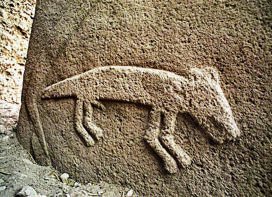Discovering the world’s oldest temple in photos
ISTANBUL

The exhibition at the İstinye Park Shopping Mall features 25 photos of animal figures found during excavations that have been continuing since 1995. DHA Photo
A photography exhibition taking place in the framework of a project to promote Göbekli Tepe, considered the world’s oldest temple in the eastern Turkish province of Şanlıurfa, is set to meet Istanbul audiences. The Göbekli Tepe Promotion Project is sponsored by Doğuş Group.
The first exhibition of the project was opened on Nov. 24, 2013 in Şanlıurfa and it will be open for visits at İstinye Park Shopping Mall until March 10.
The exhibition features 25 photos of animal figures found during excavations that have been continuing since 1995. Reliefs of wild animals and plants carved on T-shaped pillars are considered to be the first examples of sculpture and bas relief arts. The Göbekli Tepe depictions are the oldest examples of the art of rock drawing.
In the exhibition, the animal figures in Göbekli Tepe, which were embossed through UV printing technology, have been put on display.
“While getting ready and arranging the exhibition of our project, we carefully chose the animal depictions for our project. Staying loyal to the originals, we photo-printed these animal depictions on ceramics. We put all information and visuals of our project on the website,” said Ece Vahapoğlu, the project coordinator.
“Through an exhibition of visual richness, social media and the press, we’d like to do a promotion of this ancient site both for our citizens as well as the rest of the world,” she added.
 A worship center
A worship centerGöbekli Tepe is not considered as a settlement. Rather, dating back 12,000 years ago, it is a pre-pottery Neolithic worship center, according to the information provided by the project catalogue. The archeological excavations have demonstrated that Göbekli Tepe is a Neolithic Site, where ancient people gathered and worshipped. It is not definite yet, but these people are thought to have buried the Göbekli Tepe sanctuary.
Among the remains at Göbekli Tepe are heads of wolves, wild boars, cranes, bulls, wild ducks, storks, snakes, scorpions, wild sheep, lions, spiders and headless human body engravings, and male organs of exaggerated dimensions. Findings reflect that the people lived 12,000 years ago in permanent and semi-permanent settlements.
Bulls, wild boar, foxes, snakes, cranes and wild ducks are the most frequent animals depicted in the ancient site. Along with depictions of animals engraved on stones, three dimensional reliefs were found in the area. The most important one is the relief of a lion crawling down a “T” shaped pillar.
Following Istanbul, the exhibition will move to Şanlıurfa once again to be put on display at the Vali Kemalettin Gazezoğlu Culture and Arts Center until April.

 A worship center
A worship center